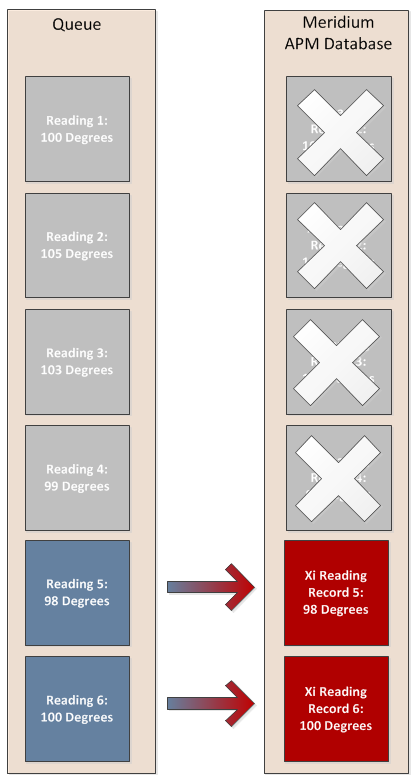In some cases, per OPC Tag record, your database might contain more OPC Reading records than you specified. This is because readings are processed by the Process Data Integration Service in batches of 1,000 and the service will transfer all new readings that it finds in each batch of 1,000, even if that number is higher than the number you specified in the Max Readings field.
After the initial batch of readings is transferred, the service will continue processing 1,000 readings at a time and transferring new readings that exist in that batch. As new readings are transferred, OPC Reading records storing older readings will be deleted automatically if they exceed your specified limits. Eventually, as the number of new readings in the processed batch matches the number in the Max Readings field, your database will contain only that number of OPC Reading records for that tag.
This concept is best understood through an example.
Suppose you specified that you want to store two reading values, but when the Process Data Integration Service runs to collect the initial set of reading values, it finds four readings. In this case, all four readings will be transferred to the GE Digital APM database. This means that you will end up with four OPC Reading records. The following image illustrates this scenario.
In the image, the blue boxes on the left represent the readings that are collected from the queue by the Process Data Integration Service. The red boxes on the right represent the OPC Reading records that get created automatically in the GE Digital APM database.

Now, suppose that the Process Data Integration Service runs again and finds an additional two readings. In this case, the two new readings are transferred to your GE Digital APM database. Also, because you configured the system to store only two readings, all four OPC Reading records representing the previous four readings are deleted automatically. This scenario is illustrated in the following image.
In this image, the gray boxes on the left represent the previous four readings. The blue boxes represent the new readings. In addition, the OPC Reading records that are deleted automatically are colored gray and contain an X over them to indicate this automatic deletion. The red boxes represent the new OPC Reading records that are created automatically.

Finally, suppose that the Process Data Integration Service runs once more and finds one more new reading in the queue. In this case, that new reading will be transferred to the GE Digital APM database as an OPC Reading record, and one OPC Reading record will be deleted automatically so that the GE Digital APM database always contains only the two most recent readings. This scenario is illustrated in the following image.
In the image, the blue box on the left represents the new reading. The red boxes on the right represent the OPC Reading records that exist in the GE Digital APM database to store the two most recent readings.
